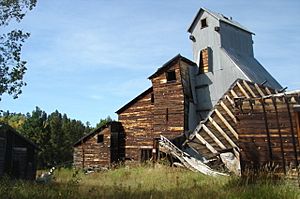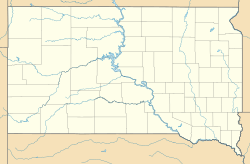Tinton, South Dakota facts for kids
Quick facts for kids
Tinton, South Dakota
|
|||||||||||||||||||||
|---|---|---|---|---|---|---|---|---|---|---|---|---|---|---|---|---|---|---|---|---|---|

Shaft house near Tinton
|
|||||||||||||||||||||
| Country | United States | ||||||||||||||||||||
| State | South Dakota | ||||||||||||||||||||
| County | Lawrence | ||||||||||||||||||||
| Founded | late 1800s | ||||||||||||||||||||
| Abandoned | 1950s | ||||||||||||||||||||
| Elevation | 5,961 ft (1,817 m) | ||||||||||||||||||||
| Population
(2013)
|
|||||||||||||||||||||
| • Total | 0 | ||||||||||||||||||||
| Time zone | UTC-7 (MST) | ||||||||||||||||||||
| • Summer (DST) | UTC-6 (MDT) | ||||||||||||||||||||
|
|||||||||||||||||||||
Tinton is a ghost town located in the Black Hills of South Dakota, in a place called Lawrence County. It started as a gold mining camp in 1876. Later, people also found and mined tin there. The town slowly became empty in the early 1900s because mining wasn't as popular. By the 1950s, everyone had left. From 1937, Tinton was home to the Dakota Tin and Gold Mine. This important mine was added to the National Register of Historic Places in 2005.
Contents
History of Tinton
How Tinton Started
The Tinton area was first settled in 1876 by Edgar St. John. He lived there until he passed away in 1928. In that same year, tin was found in the area. It was found in placer deposits, which are like loose bits of rock and sand.
In 1879, a lot of gold was discovered in a spot called Negro Hill. This hill was just south of where Tinton is today. Finding gold caused the town to grow very quickly. Then, in 1884, more tin was found inside a type of rock called pegmatite. This discovery helped the town grow even more. It also made the mining operations switch from mostly gold to mostly tin.
Life in a Mining Town
By 1904, a company called the Tinton Company had built Tinton. It was a company town, meaning the company owned most of it. Over the years, other companies also owned the town. These included The American Tin Plate Company and The Black Hills Tin Mining Company.
The mining buildings were very close to the town. Tinton had many important places. It had a post office, a bank, and a mill for processing ore. There was also a two-room schoolhouse and a hotel. The town had a store, an assembly hall, and a blacksmith. There was even a weekly newspaper! At first, there were six houses for miners and their families. Later, at least 14 more houses were built.
People once thought about building a railroad to Tinton. It would have come from Iron Creek in Spearfish Canyon. But this plan never happened. By 1911, over 104,987 pounds (about 47,621 kg) of tin had been mined from just one mine, the Rough and Ready Mine. Other mines nearby were also very successful.
The Dakota Tin and Gold Company
In 1934, a person named W.O. Fillmore bought a large piece of land. It was about 334 acres (135 hectares) near Tinton. In 1937, he started his own company called the Dakota Tin and Gold Company. He quickly built several new buildings. These included a new shaft house near the existing mine. He also built an office for testing minerals, cabins, sheds, and two dams.
Mining was stopped in 1942 because of rules during World War II. The mine never reopened after the war ended. In 2005, about 5 acres (2 hectares) of the main Dakota Tin and Gold Mine site were added to the National Register of Historic Places. This means it's an important historical place.
When Tinton Became a Ghost Town
Mine production started to slow down in the 1910s. But mining continued off and on until the 1950s. In the 1930s, a sawmill was built in Tinton. This happened because the mining was not doing as well. The mine briefly started up again during World War II. It began to produce feldspar, lithium, and more tin. However, the mines were losing money. They closed down again within ten years.
The town became empty after a fire destroyed the mill in the 1950s. Today, a mining company called Tinton Enterprises manages the area. The mines are now working again. They are digging for a metal called tantalum.
Where is Tinton Located?
Tinton is located deep inside Spearfish Canyon. This canyon is in the Black Hills of Lawrence County, South Dakota. Part of it is also in Crook County, Wyoming. The main street of the old town used to run right along the border between Wyoming and South Dakota. However, most people agree that the town is mainly in South Dakota.
Tinton is about 6 miles (9.7 km) west of Iron Creek. The town is built on a hill. From there, you can look down into the valleys to the east and west. These valleys are full of old mines. Today, you can reach Tinton using National Forest Road 222. Several other ghost towns are nearby. These include Mineral and Welcome, Wyoming.
Many of the old buildings in Tinton are still standing. But some have fallen down. Also, there is no glass left in the windows. A modern mining operation has replaced the buildings that were on the Wyoming side. Historically, the Wyoming side had the hotel, school, post office, and blacksmith shop. These buildings were all destroyed in 1996. The South Dakota side of town has mostly been left untouched.




